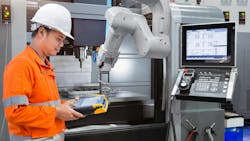Manufacturing Day 2025: A Skilled Workforce Should Be the Nation's First Priority
Key Highlights
- U.S. educational pathways favor college degrees over technical training, resulting in fewer engineers and apprentices compared to global competitors like Germany and China.
- Expanding apprenticeships and technical certifications and publicizing reshoring success stories can attract more youth to manufacturing careers and improve workforce quality.
- Certificate and license training pays off, yet most government funding goes to financial aid for college education, not technical trianing.
A widening skills gap threatens to further erode U.S. manufacturing competitiveness and thus our economy. A talent pipeline with a sufficient supply of properly aligned skills is imperative in meeting U.S. manufacturers’ needs for capacity, productivity, and innovation.
The United States was so rich for so long that efficient utilization of human resources did not seem necessary. Not true today. Income is stagnant and declining vs. many other countries, especially for the bottom third of the income distribution. It’s time to provide a path for more of our youth to obtain the technical skills necessary for today’s job market. Doing so will also mean that fewer pursue liberal arts university degrees.
The Dilemma
According to a study by Deloitte, an estimated 3.8 million manufacturing jobs will need to be filled over the next decade due to retirements (2.8M), industry growth (0.76M) and Biden era incentives (0.23M), with a skills gap leaving more than 2 million of those jobs unfilled. The gap is a result of an overall shortfall of recruits and a mismatch between the skills manufacturers need and the skillsets of available workers.
A surge in reshoring would increase that gap by millions more.
Skilled workforce development is one competitiveness factor that the U.S. government, in collaboration with industry, has complete control over. Worker quantity is essential for the United States worker to provide the needed capacity increase for expansion, reshoring and foreign direct investment (FDI). But the U.S. also needs sufficient worker quality to overcome our lack of cost-competitiveness.
Any reasonable mix of a lower U.S. dollar, lower corporate tax rates, or value-added tax would raise cost-competitiveness. But a skilled workforce is essential for capacity competitiveness. The Initiative’s goal is a 40% increase in manufacturing, i.e. 5 million manufacturing jobs, it the sine qua non—the essential condition—of successful reshoring.
Workforce Impact
Global manufacturing executives have ranked the search for skilled talent as the No. 1 driver of manufacturing competitiveness. On one occasion, I took a group of top U.S. apprentices to see the Swiss apprenticeship system. A manager of one of the Swiss machine tool companies mentioned that when they are developing programs for a complex part, they break the process into two setups for the U.S. but one setup for Germany and Switzerland. The typical U.S. operator/programmer cannot handle the more complex process due to training deficiency. The result: higher manufacturing cost and longer deliveries in the United States.
Where Is the Talent?
Baby boomer retirements impact the availability of suitably skilled recruits, along with an absence of new recruits due to factors such as our younger generation’s negative perception of manufacturing; lack of STEM (science, technology, engineering and mathematics) skills among students and workers; a decline of technical education programs in public high schools and a lack of diversity in those programs. The new-collar workers we need today must develop technical and soft skills through nontraditional educational paths.
New-Collar Jobs
New technologies are transforming work at an unparalleled pace due to leading-edge technologies like artificial intelligence, advanced robotics and cognitive automation and advanced analytics. New-collar workers must develop technical and soft skills through nontraditional educational paths including community colleges, vocational schools, software boot camps, technical certification programs, high-school technical education and on-the-job apprenticeships and internships as opposed to a four-year university degree. Manufacturers must incorporate lifelong learning into their business plans to develop the future workforce needed for smart factories.
Talent Shortage Root Causes
- Worker availability is an issue in almost all developed countries and increasingly in developing countries. As income rises, students are encouraged to pursue four-year college degrees instead of technical training.
- We graduate fewer engineers and apprentices than nations we compete with. For example, in 2020, among first university degrees, only 7.9% of U.S. degrees were in engineering compared to China (32.8%) and Germany (23.3%). In 2024, about 50% of 18-24 year old Germans earned apprenticeships vs. the United States, where it is less than 5%.
- The nation encourages university education, via grants, loans, etc., but we need to support more apprenticeship programs. The scale of federal student aid is about $160+ billion per year for student aid vs. a few hundreds of millions for apprenticeship grants and expansion programs. Even when adding in the more fragmented federal and state apprenticeship program funding, it still doesn’t come close to the scale of college financial aid.
- The high rate of offshoring and resulting factory closings, especially from 2000 to 2010, has convinced many students, parents and guidance counselors that manufacturing is an unstable career. Publicizing the high rate of growth in reshoring since 2010 helps to overcome this image. Since 2010, over 2 million jobs have been announced. Approximately 10% of current U.S. manufacturing jobs have been reshored since 2010.
Training Pays
Certificate and license training pays off. In 2025, a graduate with an associates degree or technical diploma with mid-range specialization (e.g. moderate experience with some technical skills like a CNC operator) would earn approximately $50,000 to $65,000 per year. A high-end technician trained in a specialized technology like CNC programming or automation could earn as much as $65,000 to $80,000 annually, or more in high-demand areas.
Entrepreneurial opportunities are also prevalent. Thirty-five percent of owners of machining and tool and die shops are apprenticeship graduates and 28% are trained machinists.
The misperceptions about manufacturing careers must be changed to help communities motivate students and develop a larger, smarter, better-trained skilled manufacturing workforce.
Skilled Manufacturing Technologists or “Middle-Skills”
Words matter. Stop referring to “trades and vocations” for jobs requiring significant post-secondary training, such as apprenticeships. More informative categorizations of certain occupations—such as “skilled manufacturing technologist” instead of the more generic "middle-skills worker"—can result in more recruitment for skills training.
Categorize skill level by the work accomplished, not by the number of degrees workers hold. The complexity and expertise required in professions like CNC machining or toolmaking are often underestimated. For example, is an apprentice CNC machinist or toolmaker any less skilled than a college graduate working in an insurance company? The answer is no. Technical craftsmanship requires a level of skill and precision that is just as valuable as the skills needed for business operations.
U.S. Global Competitiveness
Our goal to be globally competitive depends upon generating skilled toolmakers, precision machinists, welders, etc. and an engineering workforce as good as those in Germany and Switzerland. As manufacturers increase competitiveness with automation and other new technologies, the workforce will need comprehensive training and corresponding skills to interact and grow.
How Do We Get There?
A Harvard Business School study determined that leaders from business, education, and government must collaborate and take action collectively to upskill and reskill the U.S. workforce. For help, contact the Reshoring Initiative at (847) 867-1144 or email me at [email protected]
About the Author

Harry Moser
Founder
Harry Moser, founder of the Reshoring Initiative, grew up experiencing the glory of U.S. manufacturing. With more than 45 years of manufacturing experience (most recently 25 years as president, chairman and then chairman emeritus of GF AgieCharmilles), Moser is a leading industry spokesman for reshoring and for developing the skilled manufacturing workforce required by reshoring.
The not-for-profit Reshoring Initiative ‘s Mission is to bring back U.S., and more generally North American, manufacturing jobs by helping companies see that, increasingly, they will be more profitable if they produce and source in or near their market.
